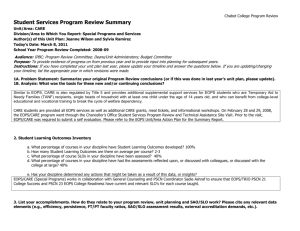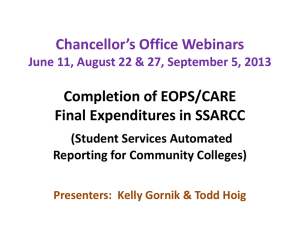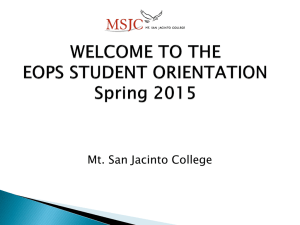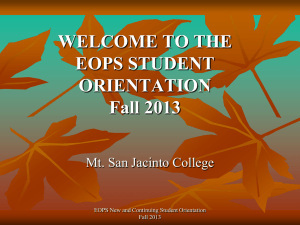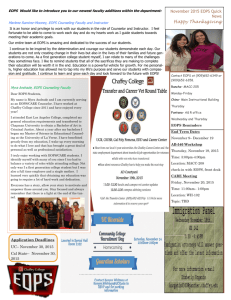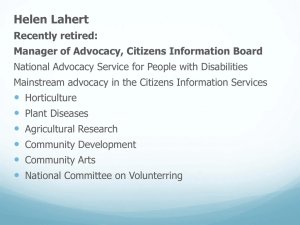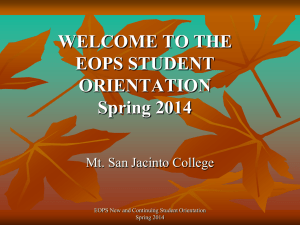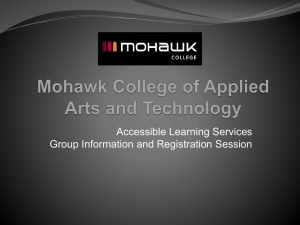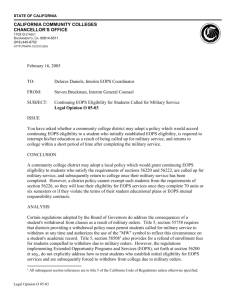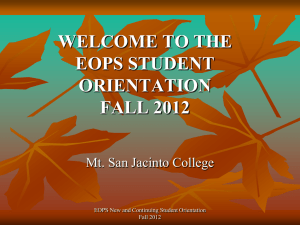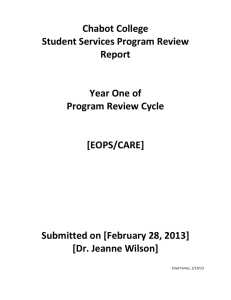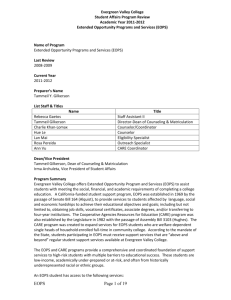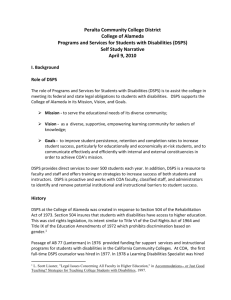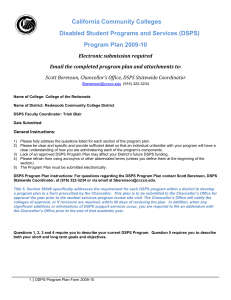What is EOPS? - College of the Redwoods
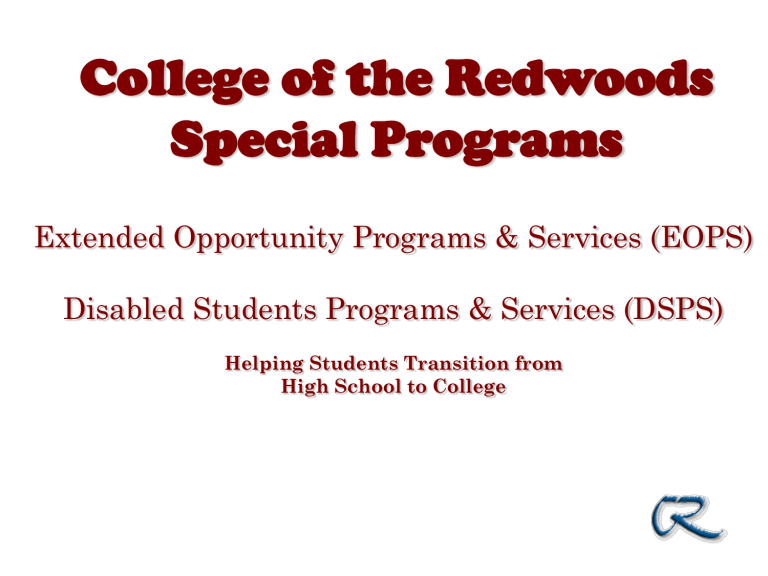
College of the Redwoods
Special Programs
Extended Opportunity Programs & Services (EOPS)
Disabled Students Programs & Services (DSPS)
Helping Students Transition from
High School to College
What is EOPS?
Extended Opportunity Programs &
Services (EOPS)
• History
• Purpose
• Requirements
• Services
EOPS History
• Extended Opportunities Programs &
Services
• Began in 1969
• Social Reform Program of California
Community Colleges
• Currently serves 1,400 CR students
EOPS Purpose
The mission of EOPS at College of the
Redwoods is to identify students affected by language, social and economic disadvantages, and to assist those students to achieve their educational objectives and goals.
EOPS Eligibility
• Enrolled full-time (12 units or more)
• Board of Governor’s (BOG) method A or B eligible
• Have not completed 70 semester units
• Educationally disadvantaged
– Remedial math and/or English placement
– No high school diploma
– First generation college student
– Underrepresented population
EOPS Requirements
• Academic progress (complete at least 75% of units attempted with
2.0 GPA)
• Attend an EOPS Orientation
• Three contacts per semester (two with Counselor and one with
Advisor, Peer Mentor, or Student
Services Specialist)
• Complete Student Education Plan
(SEP) and update once per semester
• Complete EOPS Exit Interview before leaving CR
EOPS Services
• Counseling/advising
• Student planner
• Priority registration and workshop
• Book voucher/parking pass or bus pass
• Peer mentoring and tutoring (new Mentor
Center in ASC!)
• Transfer and career exploration
• CARE and CR CalWORKs programs
• Bridge-Way Club
• Learning Community opportunity
Other Special Programs
• Learning Community
– Linked classes. English 350 and General Studies
• CR CalWORKs
– Parent receiving cash aid from Department of Health and Human
Services
• CARE
– Single parent of child receiving cash aid from Department of Health and Human Services
• Clubs
– Bridge-Way (students raised in foster care or feel like they raised themselves)
Want more information?
• Give us a call
707.476.4270
• Send us an email sheila-hall@redwoods.edu
eops-staff@redwoods.edu
• Visit the website http://www.redwoods.edu/eureka/eops/
Who is DSPS and what does it do?
• Established by California Education Code Title V to serve students with disabilities in California
Community Colleges.
• Charged with determining eligibility and providing reasonable academic accommodations for students with disabilities.
• Supports nearly 1200 students district wide by providing services and accommodations to those who qualify.
What kinds of services do we provide students?
• Priority registration
• Note takers
• Sign-language interpreters and real-time captioners
• On-campus transportation services (bus, scooters)
• Tape recorders and MP3 players
• CD or electronic texts (e-text)
• Large print material and Braille
• In-classroom furniture
• Learning Disabilities assessment
• Instructional support
• Assistive technology
• Testing accommodations
• Academic counseling and advising
Who qualifies for services?
• Students with verified learning disabilities.
• Students with verified psychological disabilities.
• Students with verified physical disabilities.
• Students who are blind or have low vision.
• Students who are deaf or hard of hearing.
• Students with acquired brain injuries.
• Students with developmental disabilities.
• Students with speech or communication disorders.
• Other disabilities (e.g. ADD, ADHD, health conditions such as cancer, HIV, epilepsy, etc.)
IDEA and Section 504
• IDEA (Individuals with Disabilities Education Act of 2004):
Federal legislation that describes the rights of K-12 students with disabilities.
• IEP (Individual Education Plan): IDEA-required plan of individual K-12 students goals and objectives.
• Section 504: Part of the Federal Rehabilitation Act.
Protects the civil rights of children and adults with disabilities in schools and workplaces that receive federal financial aid.
• 504 Plan: Plan that outlines accommodations and services for K-12 student with disabilities who is outside of IDEA.
ADA, 504, & Post-
Secondary Education
• Accommodations: Appropriate academic adjustments to the learning experience.
• Verified disability that limits one or more major life activities, resulting in an educational limitation.
• An educational limitation is a disability related functional limitation in an educational setting.
• May not alter the fundamental nature of a course.
K-12 & College: The
Differences
Student
Records
IDEA
Student records accessible by parents
504 Plan
Student records accessible by parents
College ADA
Student records accessible by student only
K-12 & College: The
Differences
Conduct
IDEA
Special consideration for behavior
504 Plan
Follows high school behavior code
College ADA
Follows college
Code of Conduct
K-12 & College: The
Differences
Disability
Verification
IDEA
District identifies
504 Plan
Parent provides documentation
College ADA
Student provides documentation
K-12 & College: The
Differences
“Special
Education”
& curriculum modifications
IDEA
“Special
Education” classes & curricular modifications
504 Plan
Regular class/ curriculum with modifications
College ADA
No “special ed.”
No modified curriculum.
Accommodations
K-12 & College: The
Differences
Advocacy
IDEA
Teacher and
IEP team advocate
504 Plan
Parent and
Student advocate
College ADA
Student
Advocates for self
K-12 & College: The
Differences
Personal
Services
IDEA
Transportation, personal attendants, nurse readers for study
504 Plan
No personal services provided
College ADA
No personal services provided
What should you know to best help a high school student transition to college?
• Let students know they are not automatically eligible to receive the services in college that they received in high school.
• DSPS services are voluntary a student must request accommodations.
• Verification of disability is the responsibility of the student seeking accommodations. The verification must be provided by a licensed professional in a disability –related field.
• Although an IEP or 504 Plan may help identify services that a high school student received, it in and of itself is not sufficient as it does not contain all required elements for verification of disability.
Want more information?
• Give us a call: 707-476-4280
• Send us an email: tracey-thomas@redwoods.edu
• Visit our website: http://www.redwoods.edu/District/dsps
• Want the DSPS high school to post-secondary transition guide?
http://www.redwoods.edu/district/dsps/transitionguide
• Want the Office for Civil Rights, Students with Disabilities
Preparing for Postsecondary Education publication?
http://www.ed.gov/ocr/transition.html
